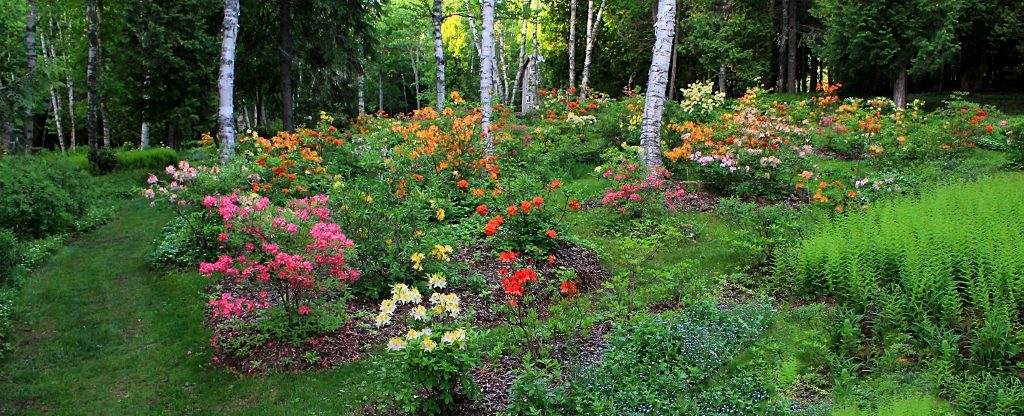A Resurrection Garden
By Freeman Patterson

c 2017 F Patterson
My rhododendron and azalea garden, which now contains more than 1000 plants, is rather like the fictional Topsy who “just grew.” It began in the rather hazy past, sometime about 14 years ago, when I was only three. No, my birthday does not fall on February 29, but I count my years from January 29, 2000, when I underwent the second of two liver transplants (within five days) in Halifax’s Queen Elizabeth II Hospital. I spent a relatively happy winter there, in an induced coma, while all of my friends did the serious worrying. I had been given less than a one per cent chance of survival.
About the middle of May, after I had learned to hold my head up straight, then to stand up, and eventually how to walk again (first with a walker, then a cane), I was released.
As I’d been gardening seriously with both flowers and vegetables since about the time I had started school, all my instincts were to plunge my hands immediately into soil, but of course I couldn’t. Not for a couple more years. However, I could give instructions! So, my long-time employee, neighbour, and good friend, Joanne Nutter, who knew next to nothing about gardening at the time, became both my student and my work horse. Fortunately, Joanne is totally unafraid of hard physical labour and she took to gardening like lobsters take to the Atlantic Ocean. Within a couple of years we were happily gardening together, usually starting about 5:30 a.m. in late May and June, when the light is beautiful, the temperature is usually cool, and most of the bugs are still asleep.

c 2017 F Patterson
Arneson’s Gem azalea in foreground
In 1998 I had donated my 200 acres at the junction of the St. John River and its tributary, the Belleisle, to the Nature Conservancy of Canada, retaining only a life tenancy. NCC was able to add another 100 acres, so I live on a 300-acre natural area that, for the most part, will remain forever wild. However, I can interact freely with nature for a few acres in a circle surrounding my house, and it was in the old woods behind my house that Joanne and I began to plant azaleas and rhododendrons – just a few at first, but increasingly more and more as the years went by. I decided to work with the rhodo family because about 25 years earlier, when I knew nothing whatever about rhodos, I had put more-or-less accidentally a gift English Roseum in exactly the right spot. After growing vigorously for five years, it decided to bloom again and became larger and lovelier with every passing year. It became my guide.
As the years passed, Joanne, her husband, and I cut down dead trees, burned the slash, carried out logs, and then I planted immediately in each new area. Since the network of roots made digging impossible, I placed virtually every plant on top of the ground, surrounding it with good horse-manure compost (+ a bit of Pro Mix) and a layer of regular spruce mulch. I certainly wasn’t worried about the acidity of the soil, as blueberries and Rhododendron canadense proliferated in untouched open spaces. Of course, I was learning fast and reading everything I could about growing rhododendrons.
When my woodland garden numbered about 600 plants, I discovered that Capt. Dick Steele had been testing rhododendrons and azaleas at Tyng Hill, his brother’s property just three km. from me, but also, as both Dick and Joe had passed on, that all the azaleas and many of the rhododendrons were being taken over by forest. I approached the family member who was responsible for the property and asked to “borrow” all the azaleas, pointing out that if they remained where they were, nobody would ever enjoy them, but if I moved them to my garden, the entire Steele family and many others could enjoy them again and again.
My suggestion was accepted. Early in November of 2012, Joanne and I dug up all 100 azaleas (small and large) and brought them to my garden. We managed about a 95% survival rate, although some of the larger ones survived only because I pruned them severely. Since that time I have been returning to Tyng Hill and prowling the woods to find naturally-layered branches of overgrown rhodos, that I’m also moving with real success. Harold Popma has helped me identify some of these, such as ‘Minas Grand Pré’, ‘Walter Ostrom’, ‘Running Deer’, and ‘Boulderwood’. I found one huge rhodo that still had a label, a very old variety: ‘Lady Grey Egerton’. It had two layered branches. I planted one that stands eight feet tall and gave the six-foot branch to Harold, who has it in his Sackville garden.
Although I have purchased most of my plants from Maritime nurseries – Scott’s in Fredericton, Brunswick in Quispamsis, Corn Hill near Sussex, Cedarcrest in Saint John, Canada Green in St. George, and Baldwin’s in Falmouth – increasingly I have been securing plants from Jack and Jackie Looye’s Rhodo Land Nursery in Niagara-on-the-Lake, Ontario. I usually make some personal selections but also ask Jack to choose for me, so I’m growing several crosses, many his own. At present I have about 175 rhododendron varieties and about 50 azalea varieties growing in a range of continuous open woodland settings – hardiness zones 4b to maybe 6a.
Joanne has retired, but comes often to visit, and Joel MacPherson, an extremely fit young neighbour with a degree in forestry and horticulture as well as all the practical skills I could ever hope for, has joined me part-time in the garden. The labour of love goes on.
*Hover mouse over image to display descriptions, click to advance slide show. All images the property of Freeman Patterson, used with permission.










